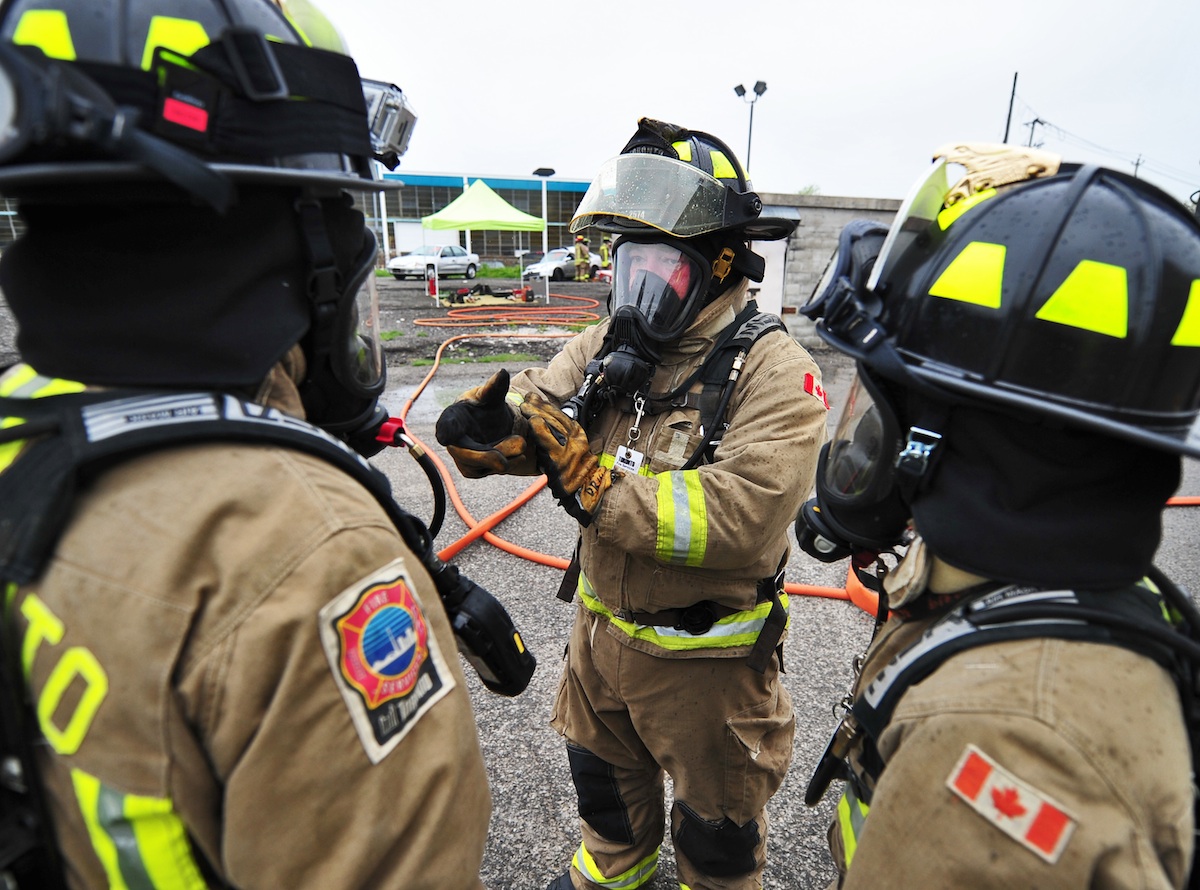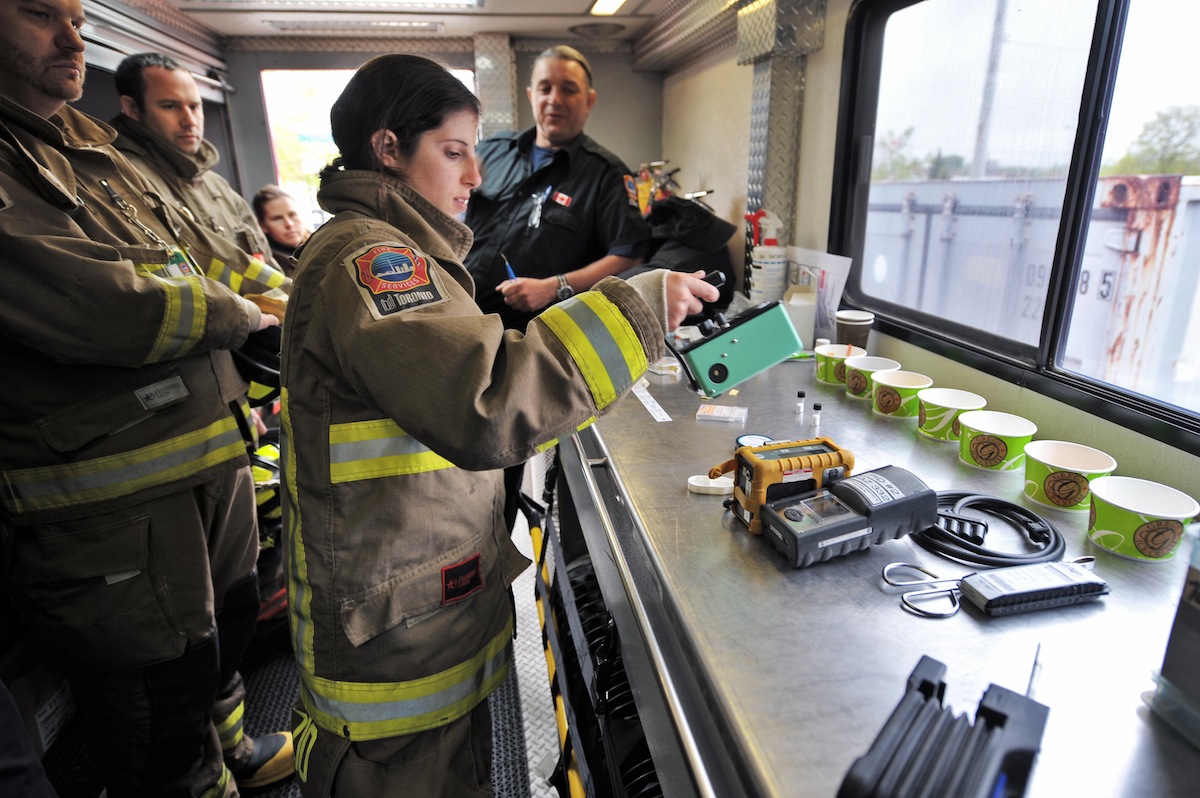
Features
Blogs
Guest blogs
Guest blog
May 30, 2013, Toronto – I’ve been the assistant editor for Fire Fighting in Canada for more than a year now, so I wouldn’t consider myself a total newbie to the fire service. But, as my participation in the 2013 Toronto Fire Ops on May 10 proved, I’ve still got a lot to learn.
May 30, 2013
By
Olivia D'Orazio
May 30, 2013, Toronto – I’ve been the assistant editor for Fire Fighting in Canada for more than a year now, so I wouldn’t consider myself a total newbie to the fire service. But, as my participation in the 2013 Toronto Fire Ops on May 10 proved, I’ve still got a lot to learn.
As usual, everyone at the training centre was warm and friendly – I have yet to meet a rude firefighter. After a brief medical exam (during which Rose, a firefighter, assured me that my sore throat was nothing to be concerned about, just drink lots of water), the rest of the participants and I convened in the auditorium for breakfast.
Lesson No. 1: Firefighters like to eat.
This might not be anything entirely new to me – I once watched two firefighters essentially order one of everything, eat it all without breaking a sweat, and call it “first lunch” – but once the covers came off of the muffin trays, the hall filled with more folks in uniform than I thought were even in the building.
While we ate, I listened in on a conversation between one of the participating councillors and Toronto Fire Chief Jim Sales. Sales was explaining that response times don’t consider the vertical distance to fires in highrise buildings. In recent years, Toronto’s skyline has become littered with crane after crane after crane – as of March 2012, there were 185 highrise buildings under construction in the city, more than New York City, Chicago, Vancouver and Calgary combined. Sales’ frustration comes as the fire services’ response-time standards aren’t changing with the city’s landscape.
As I pondered a solution – I’m stuck for one, by the way – I understood why firefighters like to eat: they need their energy.
As a proud member of the Blue Team, I was lucky to go through some of the more exhausting rotations at the start of the day (and before the clouds got to look too menacing). After getting geared up, we were ready to go.
 |
| FFIC assistant editor, Olivia D'Orazio and the Blue Team are briefed before their live fire rotation at Toronto Fire Ops on May 10. Photo by John Riddell. |
Lesson No. 2: Fit is important.
Those with a narrow face like mine can attest to the problems this causes – every pair of sunglasses looks ridiculously oversized, one-size-fits-all hats are a cruel joke, and properly fitted SCBA masks are hard to come by. Luckily, one of the real firefighters there let me borrow his personal backup mask. The rest of my gear was still a bit roomy – gloves, boots, jacket – but at least there was no serious discomfort.
I looked at Lisa (I think – I couldn’t hear her when she said her name!) who was about my height – though her seven years of service had kept her in significantly better shape. Her gear fit her perfectly.
We moved on to the first drill of the day: car fires. I’ve held a handline before, but I’m starting to think it wasn’t at full pressure. This time around, I found myself needing help to completely open the stream. . . and to turn the nozzle all the way to a straight stream. . . and to completely close the nozzle. . . and to stand up after the evolution. Suffice to say, I now understand why we run so many fitness columns!
(As an aside, I’m proud to report that I can actually hold and operate the hydraulic auto-ex tools without any help. That push-up I did last year really came in handy.)
Lesson No. 3: The Jaws of Life aren’t the only toys that fire departments have.
After a large and busy lunch (see Lesson No. 1!), I moved on to medical response. Having worked as a lifeguard for many years, I was familiar with the AED, the EpiPen and the ABCs of CPR. But, I was impressed with the amazing equipment in firefighters’ first aid kits (I was particularly excited to see an Asherman Chest Seal, the unicorn of the first aid kit). I was especially surprised to see some of the special equipment that Toronto’s firefighters have used for some incredible real-life emergencies – gentle saws to free victims of accidental impalements or tiny cutters to open the tiny slots in drain covers, for example.
One type of emergency that I hadn’t considered were those involving trapped fingers – many of those fingers belonging to children. One example involved a child’s fingers stuck in the holes in street signs.
“Kids will sometimes stick their fingers in there, just to see if they fit,” the instructor chuckled as he explained how fire crews use a special saw to cut the pole down to a manageable length, before transporting the patient to the hospital.
Erm. . . Yeah, silly kids. . . .
Another example I didn’t think of concerned all the industrial-type accidents that can happen around the home. When someone mentions a meat grinder, I think of Oscar Meyers or McDonald’s – certainly not my grandparents’ basement (they make their own sausages, cured meats, olive oil, tomato sauce, wine and jam – needless to say, it practically is an industrial space). I’m glad to know that there are methods for getting one’s hand out of a grinder that doesn’t involve amputation – especially considering my grandfather’s just-use-your-hands policy.
Lesson No. 4: Bananas release a small amount of radiation.
Speaking of impressive toys, my last rotation was a walk through the hazmat truck. I realized how commonplace, like industrial accidents, hazmat incidents can be. Outside of the typical propane tanks that we all have lying around, I thought about that pool where I used to work. I was trained to handle a variety of chemicals – and was told which boxes, barrels and cans I was to avoid. A simple mistake could have introduced me to those firefighters-turned-chemists a lot sooner – though I’m sure they wouldn’t have been as happy to see me then!
 |
| Olivia checks a variety of substances for radiation. Photo by John Riddell. |
And, in case you’re wondering, that banana fact has nothing to do with firefighting; it was just a fun bit of information that the hazmat guys shared.
A special thanks to the folks at Toronto Fire and the IAFF, who gave all participants their own fire helmets – mine sits proudly on my desk!
For more photos from the day, check out our Facebook page!
Print this page